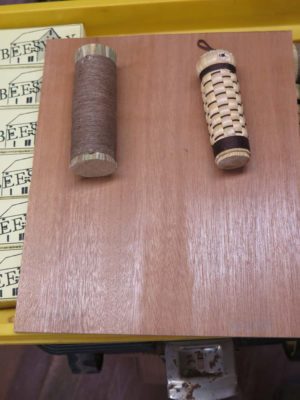A Juncus Polissor – IV

With the new Juncus polissoir made I took a minute to examine and characterize it, and give it a quick test drive. As I said earlier, it took a lot more of the rush to compress to the same density of the sorghum polissoirs I have made for me.
My immediate impression of the Juncus polissoir is that is softer and more fragile than the sorghum. The working surface just seemed softer to my fingertips and fingernail, and the fibers around the perimeter of the working tip were much more easily damaged and broken off. My deduction is that this tool could not be used vigorously as a dry tip, unlike the sorghum. Yannick Chastang implied as much when he indicated that this tool is always used with wax, although Roubo is less clear on the subject (Roubo could be a frustrating writer, often accomplishing the nearly impossible feat of being simultaneously effusive and laconic).
Due to time limitations, at that moment my only side-by-side apples vs. apples comparison I could make was to use a dry (unwaxed) sorghum polissoir and this new dry (unwaxed) Juncus polissoir on a prepped board.

Both accomplished glistening surfaces in a matter of seconds.
The visual result was pretty much indistinguishable, but there was a definite sensory difference; the Juncus polissoir seemed much softer to the surface of the wood. Even though the fibers of each were compressed as tightly as possible, the sound of them tapping on the workpiece differed; the Juncus had a much softer, more diffused sound than the sorghum. Deductively this implies that the sorghum polissoir was more efficient to Juncus in burnishing (compressing and smoothing the surface of the workpiece), yielding a “brighter” surface, but the Juncus might be superior in polishing (smoothing via rubbing abrasion) and also more forgiving. Neither strikes me as “superior” overall at this point, they just have unique characters that differ. I do suspect also that the sorghum polissoir is more robust and long-lasting than the more fragile Juncus, but that may or may not be true, and might be mitigated through wax impregnation.
As time allows in the future I will test and compare these tools further in the future, but for now that is what I have to report.



Curious how often people comment on old threads? I’ve been thinking about this series of posts a lot recently, as A) I would like a polissoir sometime this winter, and B) I planted some Juncus Effusus in our rain gardens this past spring. It didn’t hit me at first that it was the same plant you used here, but having observed the plant growing and now going into winter I remembered this post. Gardening for woodworkers is a fun concept. I intend to harvest mine, dry it, and give it a go. Only makes sense given that I need to cut it for good maintenance anyways. Depending on how it goes I may even try and make some Christmas presents. Curious if you ever followed up and soaked this in wax for further testing? Thanks for all the info you post, your blog is amongst my favorites! I hope to take a workshop with you soon-